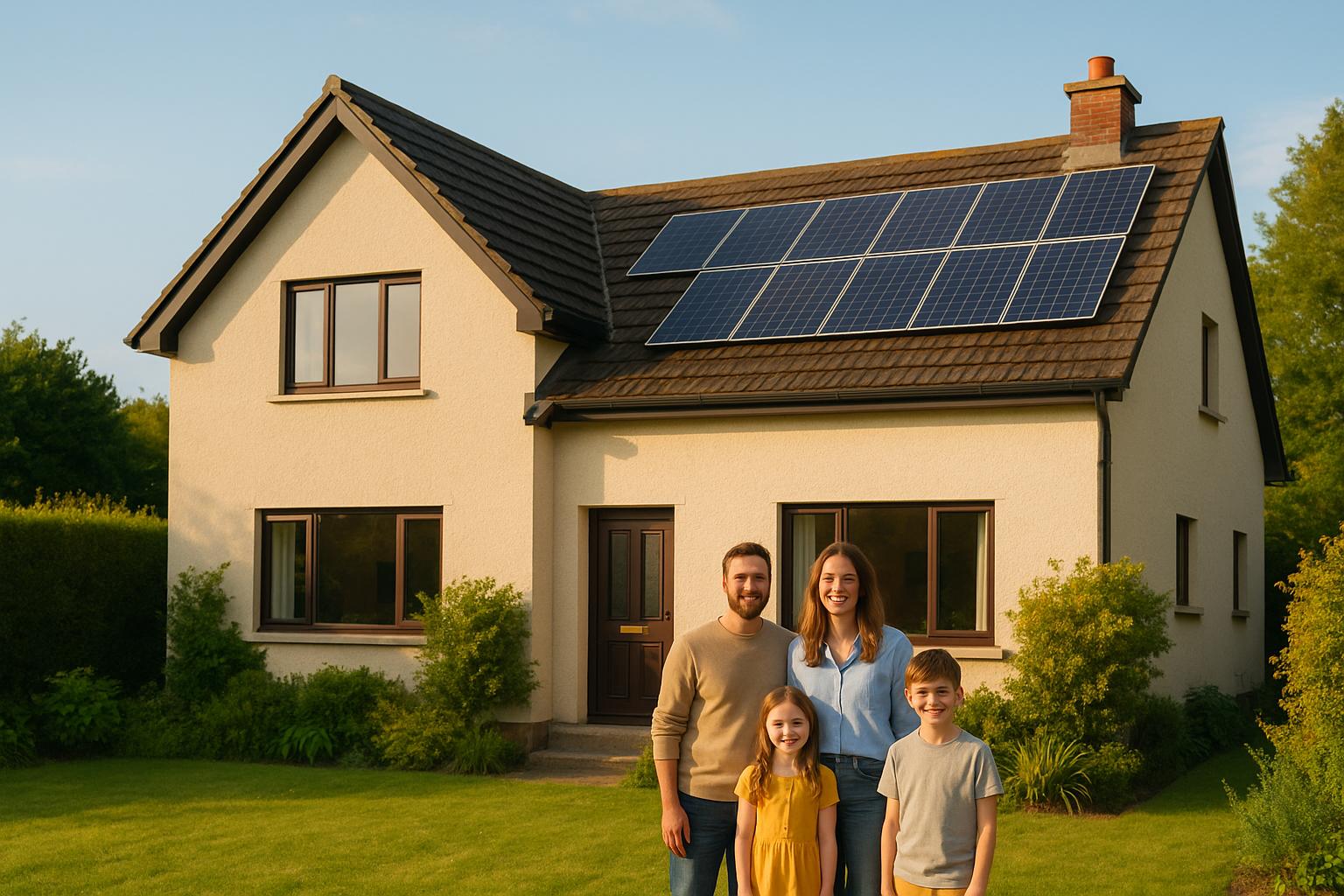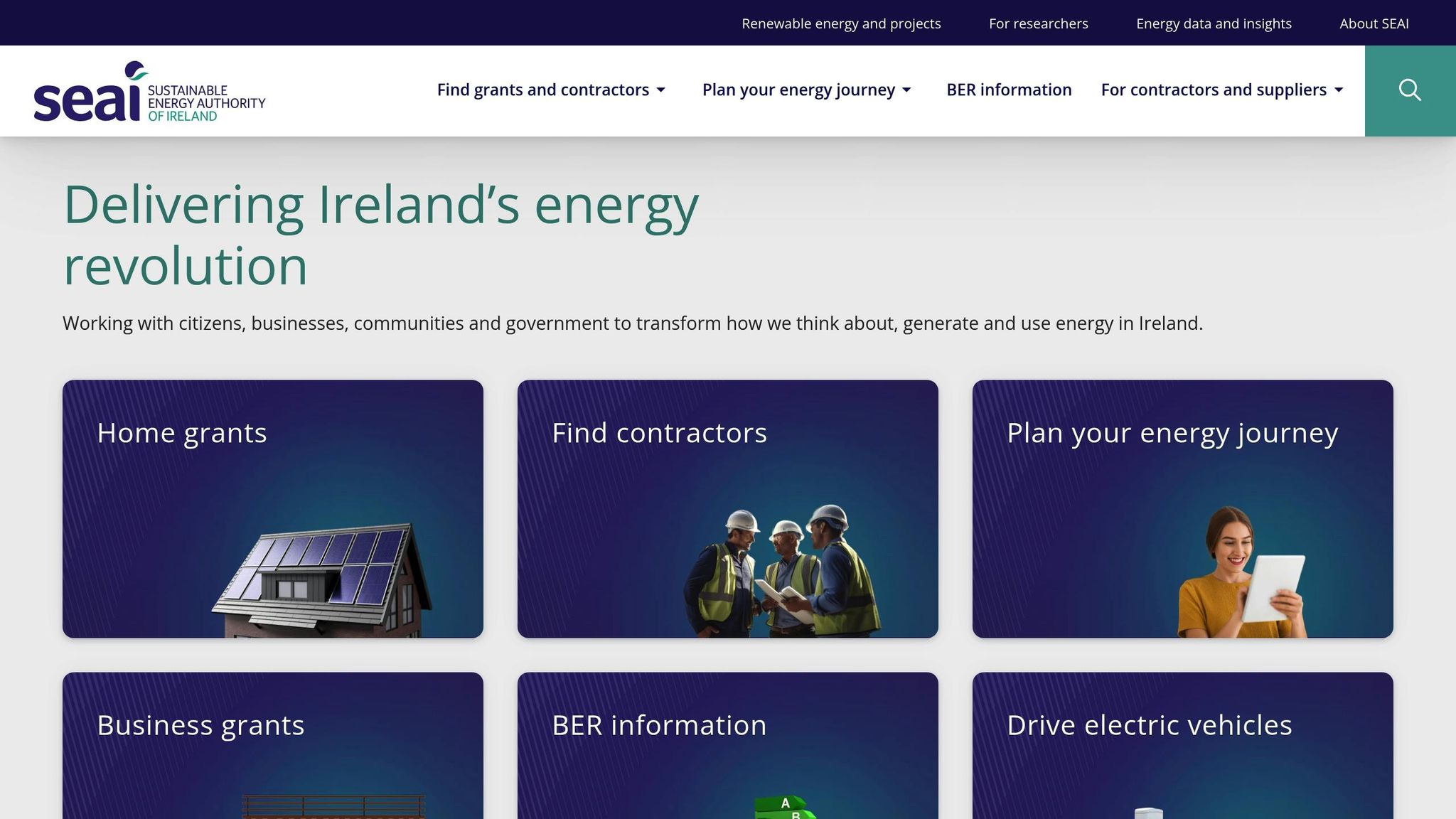Ultimate Guide to Zero-VAT Solar Costs
Ireland's zero-VAT policy on solar installations significantly reduces costs for homeowners and schools, making renewable energy more accessible.

Ireland’s zero-VAT policy on solar installations, introduced on May 1, 2023, makes going solar more affordable for homeowners and schools. Here's what you need to know:
- Savings: Homeowners save around $1,000 (11.5%) on average, reducing installation costs from $9,000 to $8,000. Schools have been eligible since January 1, 2024.
- What's Covered: The 0% VAT applies to entire solar systems, including panels, batteries, wiring, and labor.
- Eligibility: Private homes, apartments, and schools qualify. Commercial properties and short-term accommodations do not.
- Grants: Combine this with SEAI grants (up to $1,800) for even lower costs.
- Key Dates: The policy runs until March 31, 2027, after which VAT will increase to 5%.
Act now to lock in these savings and reduce energy costs while contributing to renewable energy goals.
Can I Claim the SEAI Grant for Solar PV? - Unlock Solar Savings with SEAI Grants!

How Zero-VAT Solar Policy Works
Ireland's zero-VAT solar policy changes the game for solar installation costs by eliminating the standard VAT on qualifying projects. This permanent government initiative makes solar energy far more affordable for households and recognized schools.
Under this policy, the entire photovoltaic (PV) system - including batteries, wiring, controllers, and labor - qualifies for the 0% VAT rate. The financial benefits are immediate. The Department of Finance estimates the policy will cost the government around $20 million annually, while offering direct savings to consumers, making solar installations an even more appealing option. Minister for Finance Michael McGrath emphasized the importance of this change, stating:
"The government has agreed to reduce the VAT rate on the supply and installation of solar panels to zero for private dwellings from 1 May 2023. This will result in a significant reduction in the installation cost for households and I believe will encourage more people to avail of this innovative technology."
Now, let’s break down who qualifies for these benefits.
Who Qualifies for Zero-VAT
The zero-VAT benefit is specifically aimed at private dwellings, including houses, apartments, duplexes, and even caravans or mobile homes that are permanently fixed to the ground. Ground-mounted solar systems installed near your home also fall under this policy.
Mixed-use properties can take advantage of this benefit too. For instance, if part of your home operates as a bed and breakfast, the VAT exemption applies proportionally to the residential area. Additionally, recognized primary and post-primary schools under the Education Act 1998 became eligible as of January 1, 2024.
However, not all properties qualify. Commercial buildings, hotels, public institutions, and guest houses offering short-term accommodations are excluded from the 0% VAT benefit. Similarly, electric vehicle chargers are taxed at 13.5% and are not covered under this policy.
With eligibility clarified, let’s explore the key dates and installation rules.
Policy Dates and Installation Rules
The zero-VAT policy officially went into effect on May 1, 2023, marking a major step forward for renewable energy adoption in Ireland. Unlike temporary incentives, this is a permanent change, offering long-term stability for those interested in solar installations.
Minister for the Environment, Climate and Communications Eamon Ryan underscored the significance of this initiative, saying:
"This move by Government is yet another step on Ireland's journey to cleaner, cheaper, renewable energy."
It's essential to understand that the 0% VAT rate applies only to complete supply-and-installation packages. Simply buying solar panels without professional installation does not qualify. For mixed-use properties, it’s important to work closely with your installer to clearly document which parts of the installation serve your private dwelling versus any commercial activities. This ensures you maximize your zero-VAT benefit.
Zero-VAT Solar Installation Costs
The introduction of zero-VAT for solar installations has made renewable energy more affordable, cutting costs significantly and opening the door for more households to invest in solar power.
Solar System Price Ranges
After applying the $1,800 SEAI grant, the cost of a complete solar system typically ranges between $7,000 and $10,000. The final price depends on the size of the property and the system installed. Here's a breakdown of estimated costs after the grant:
- Small terraced home (4 panels, ~1.76 kWp): ~$4,500
- 2-bedroom terraced house (8 panels, ~3.52 kWp): ~$5,650
- 3-bedroom semi-detached home (10 panels, ~4.4 kWp): ~$6,300 – this aligns with an average annual energy use of about 4,200 kWh
- 4-bedroom detached house (12 panels, ~5.28 kWp): ~$7,100
- 6-bedroom detached home (16 panels, ~7.04 kWp): ~$8,200
| House Type | Number of Panels | System Size | Cost After Grant |
|---|---|---|---|
| Small terraced | 4 panels | ~1.76 kWp | ~$4,500 |
| 2-bed terraced | 8 panels | ~3.52 kWp | ~$5,650 |
| 3-bed semi-detached | 10 panels | ~4.4 kWp | ~$6,300 |
| 4-bed detached | 12 panels | ~5.28 kWp | ~$7,100 |
| 6-bed detached | 16 panels | ~7.04 kWp | ~$8,200 |
For those interested in adding battery storage, which increases energy independence, expect an additional cost of around $1,700 to $2,200.
SEAI Grants and Zero-VAT Combined
The combination of SEAI grants and the zero-VAT policy creates a powerful incentive to adopt solar energy. The zero-VAT measure alone reduces installation costs by approximately 11.5%, bringing the average price down from $9,000 to $8,000.
SEAI grants provide up to $1,800 in direct financial support. The grant structure offers $700 per kWp for the first 2 kWp of capacity and $200 for each additional kWp (up to 4 kWp). Smaller systems benefit more proportionally from this assistance.
This financial support significantly improves the return on investment. With electricity costs at 32 cents per kWh, the payback period for solar PV systems has dropped from 7 years to about 6.2 years due to the zero-VAT savings. Many installations can cover 75–100% of a household's electricity needs, making them self-sustaining within 5–6 years.
To take full advantage of these incentives, it’s important to apply for the SEAI grant before installation begins. Use an SEAI-registered installer, request multiple quotes, and ensure you have a proper contract. Don’t forget to complete a post-installation BER assessment, as it’s a key requirement for grant approval.
Cost Changes After March 2027
The current 0% VAT rate is set to expire on March 31, 2027, after which it will rise to 5%. This increase will directly impact installation costs for anyone delaying their solar projects.
For example, a three-bedroom home with a solar and battery system priced at ~$11,000 today would cost an additional $550 after March 2027 due to the VAT change.
By acting now, homeowners can lock in the current savings. As of 2025, the cost of a full solar system with the zero-VAT benefit generally falls between $5,000 and $15,000. Combining these reduced prices with available grants makes this an ideal time to invest in solar energy.
Beyond immediate savings, solar panels provide protection against rising energy costs and long-term energy independence. With the VAT increase looming, now is the time to take advantage of these financial benefits while they last.
Money You Save with Zero-VAT Solar
Opting for a zero-VAT solar system doesn’t just save you money upfront - it continues to deliver savings throughout its lifespan. Let’s break down how these savings impact your investment.
Immediate and Long-Term Savings
One of the biggest perks of the zero-VAT policy is the immediate reduction in installation costs - by 11.5%. According to the Department of Environment, Climate, and Communications, this means the average solar installation cost drops from $10,800 to $9,600. That’s an upfront savings of approximately $1,200.
These savings are even more appealing when you consider that the zero-VAT policy is only in effect until March 2027. Acting within this window could mean faster returns on your investment.
Payback Period Comparison
The zero-VAT policy doesn’t just lower your initial costs - it also shortens the time it takes to recover your investment. With electricity priced at 32 cents per kWh, the payback period has been reduced from 7 years to around 6.2 years. For homeowners installing solar panels in 2025, payback periods are expected to range between 5 and 7 years.
Larger solar systems often see even faster returns due to economies of scale. The table below shows how the size of your system can affect both the cost and the payback period:
| Number of Solar Panels | Solar PV System Cost | Payback Period |
|---|---|---|
| 8 | ~$6,900 | 8 Years & 3 Months |
| 10 | ~$7,560 | 7 Years & 2 Months |
| 12 | ~$8,520 | 6 Years & 5 Months |
| 14 | ~$8,940 | 5 Years & 8 Months |
| 16 | ~$9,840 | 5 Years & 4 Months |
When you factor in additional incentives like the $1,800 SEAI grant, your overall financial returns become even more attractive. This combination of savings and support makes zero-VAT solar a smart choice for homeowners looking to maximize their investment.
What to Know Before Installing Solar Panels
Before diving into solar panel installation, it's crucial to confirm that both your property and chosen installer meet specific criteria. This step ensures you can take full advantage of upfront savings and long-term financial benefits, like the zero-VAT rate.
Property and Installer Requirements
To qualify for the zero-VAT rate, your property must be a private residence, as outlined in earlier eligibility guidelines. If your property has mixed uses - like a home that also operates as a B&B - the zero-VAT rate can only apply to the portion of the installation serving the private dwelling.
Selecting the right installer is just as important. To maintain eligibility for the zero-VAT rate, you need a qualified contractor who can deliver a complete solar solution. If you're planning to apply for SEAI grants, your installer must also be SEAI-registered.
Maintenance and System Life
Modern solar panels are built to last, with lifespans of 40–50 years, which is a significant improvement over older models. Most manufacturers back their panels with 25-year warranties to ensure reliable performance. This durability plays a key role in maximizing the return on your investment.
On average, solar panels degrade at a rate of about 0.7% per year, although some advanced models experience as little as 0.2% annual degradation. High-quality panels can maintain around 80% of their efficiency well beyond their warranty period.
"Although PV technology is largely self-reliant, occasional maintenance is essential to ensure they continue to perform well for years to come." – Martin Desmond, Managing Director of Wizer
To keep your system in top shape, clean the panels annually with a soft brush and water. Monitor your system's output monthly using your inverter or a monitoring app, and check the inverter display every few weeks for error codes. Every 2–3 years, schedule a professional inspection, which typically costs between $132 and $275, to ensure everything is running smoothly. Remember, inverters usually last 10–15 years and may need replacement at some point during your system's life.
Additional Considerations
Solar panels can still generate electricity on cloudy days, but it's essential to account for local weather conditions. For example, ensure proper drainage around your panels to prevent ice buildup during winter. Taking these steps will help optimize your system's performance and make the most of your zero-VAT installation.
Getting the Most from Zero-VAT Solar
Make the most of your solar investment by fine-tuning system performance, tapping into available grants, and carefully evaluating your system options.
Boosting System Performance
To get the best results, install your solar panels at an angle of 30–35° facing south. If possible, adjust the angle seasonally for even better efficiency. In Ireland, tilted panels can deliver up to 20% more energy than flat ones. System size is another key factor - aim for a setup that covers 70–90% of your electricity needs. On average, a home solar PV system in Ireland generates about 850 kWh per kWp annually.
Advanced technologies can also enhance performance. High-efficiency monocrystalline silicon panels work well in low-light conditions, while bifacial panels capture light reflected from surrounding surfaces. Micro-inverters, which optimize the output of each individual panel, further improve overall efficiency. These upgrades can help you get the most out of your solar investment.
Adding battery storage, like the Tesla Powerwall, is another smart move. It allows you to store excess energy for later use instead of selling it back to the grid at lower rates, giving you more control over your energy usage.
Taking Advantage of Grants
Financial incentives can significantly reduce the cost of your solar project. For instance, combining the SEAI grant (up to $2,400) with the zero-VAT benefit can make installation much more affordable. Installing a smart meter and signing up for the Clean Export Guarantee (CEG) scheme is another way to maximize your savings.
Keep in mind that the zero-VAT rate is set to expire in March 2027. Additionally, even a 10% drop in panel performance can delay your breakeven point by several months. To get the best returns, shift energy-intensive activities - like running appliances - to daylight hours.
Evaluating System Options
Choosing the right system is just as important as reducing upfront costs. Different configurations offer varying returns, depending on factors like location. For example, homes in sunnier regions like Wexford and Waterford can generate more energy throughout the year, leading to faster payback periods and greater long-term savings.
Take a 4 kWp system as an example. Priced at around $8,905 before VAT, grants can bring the cost down to roughly $6,505. This system can save a typical household about $1,500 per year, with a payback period of around six years.
Battery storage options, while increasing initial costs, can provide significant benefits. They enhance energy independence and offer backup power during outages. The zero-VAT rate also applies to ground-mounted or pole-mounted systems on private residential property, giving you flexibility if your roof isn’t ideal for solar panels.
In the long run, the financial benefits of solar are hard to ignore. Depending on your setup, lifetime savings can range from $60,000 to $75,000. With solar power in Ireland projected to grow at an annual rate of 32% between 2025 and 2027, early adopters stand to gain the most from this rapidly expanding market.
Conclusion: Act Now on Zero-VAT Solar
Zero-VAT solar offers a double advantage: it reduces costs while promoting renewable energy. By combining these savings with the long-term benefits of clean energy, you’ll be contributing to a more sustainable future.
The financial benefits are straightforward. Lower upfront costs and shorter payback periods make solar energy more accessible, especially with electricity prices currently averaging 32 cents per kWh.
"The move to 0% VAT on PV solar panels is another step on the journey to cheaper, renewable energy." - Eamon Ryan TD, Minister for the Environment
Installing solar panels doesn’t just save you money - it also plays a role in the broader transition to clean energy. Across Ireland, solar adoption is growing rapidly. By joining the more than 50,000 homes already equipped with solar panels - and the 17,000 new installations added in 2022 alone - you’ll be part of a community actively reducing carbon emissions. In fact, a typical residential solar system offsets roughly 3–4 tons of carbon emissions each year.
Now is the perfect time to act. With the solar energy sector in Ireland expanding quickly, driven by government initiatives and rising energy costs, current incentives like SEAI solar PV grants of up to $2,400 and zero-VAT benefits make solar installation more affordable than ever. Delaying your decision could mean missing out on these financial advantages or facing potential policy changes that might reduce them.
Modern solar panels are designed to perform even in cloudy weather, potentially saving you up to $1,000 annually on electricity bills. Plus, with the Microgeneration Support Scheme, you can sell excess electricity back to the grid, turning your solar system into both a cost-saving and revenue-generating investment. Take advantage of these opportunities now to secure the full range of benefits available today.
FAQs
How does Ireland's zero-VAT policy for solar installations lower costs for homeowners and schools?
Ireland is rolling out a zero-VAT policy for solar installations starting January 2024. This means no value-added tax will be applied to the supply and installation of solar panels for private homes and approved schools. The move is set to cut upfront costs, making solar energy more within reach for many.
With reduced project expenses, homeowners and schools can save money while embracing renewable energy solutions. Beyond cost savings, installing solar panels can boost property values and play a role in supporting a cleaner, greener future.
Who qualifies for the zero-VAT policy on solar panel installations in Ireland?
If you want to benefit from the zero-VAT policy on solar installations in Ireland, your property needs to meet a few key criteria. First, it must be a private residence built and occupied before 2021. Additionally, the solar panels must be installed either on the property itself or close by, and the project must be part of a combined supply-and-installation agreement. This initiative aims to make solar energy more affordable for homeowners while contributing to broader efforts to promote renewable energy.
How can I save the most money by using the zero-VAT policy and solar energy grants in Ireland?
Homeowners in Ireland now have a great opportunity to cut down the cost of installing solar panels, thanks to the zero-VAT policy introduced in May 2023. This policy eliminates VAT charges on solar installations, making it easier for more people to consider solar energy. On top of that, the SEAI solar grants provide up to €1,800 for qualifying systems, further reducing the initial expense.
By combining the VAT exemption with these grants, you can significantly lower your installation costs. This not only makes solar energy more budget-friendly but also boosts your return on investment over time. Plus, the shift to solar energy helps trim energy bills in the long run, offering both financial and environmental benefits.

